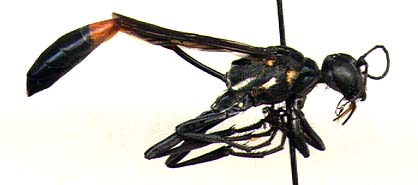Ammophila procera Dahlbom 1843. Another transcontinental North American species, A. procera ranges into Guatemala (Krombein 1979). It is widespread over much of the LP of Michigan, with only one record from the UP. It is the largest and most conspicuous Ammophila in eastern North America.
BIOLOGY: Nesting takes place in small patches of Þrm sand that are often interspersed with shrubs and trees. Burrows may be oblique or vertical with a single, large caterpillar, usually a notodontid, in the cell. Wasps at the ESGR (Livingston Co.) provisioned their nests with Heterocampa manteo (Doubleday) (Notodontidae). Krombein (1979) listed as prey Nadata gibbosa (Abbott), H. manteo, H. astarte Doubleday, Datana sp., Schizura ipomoeae (Doubleday), Symmerista spp. (all Notodontidae), Smerinthus cerisyi Kirby (Sphingidae), and Noctuidae spp. Because their prey are arboreal, the females are often found searching among the branches (especially oaks) several meters above the ground. Males can also be found among the branches where they may either be searching for mates or imbibing honeydew. Papers by Evans (1959) and Krombein (1953, 1958) contain the most extensive observations of A. procera.
FLOWER RECORDS: Asclepias tuberosa, Asclepias sp., Daucus carota
COLLECTION DATES: 165 specimens, 17 June to 3 October, with most dates ranging from early July to mid-August.

![]() BACK to Main Page
BACK to Main Page